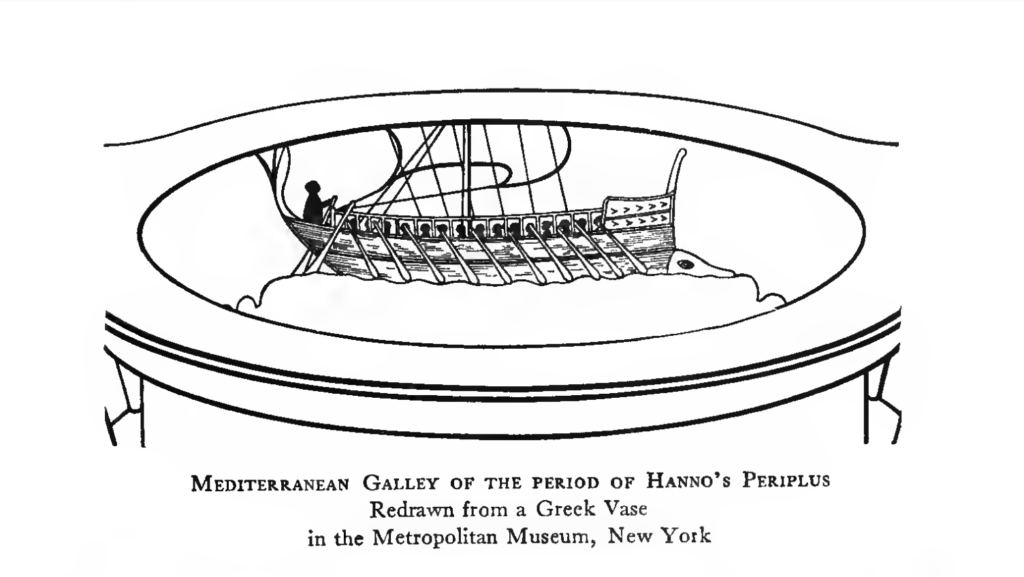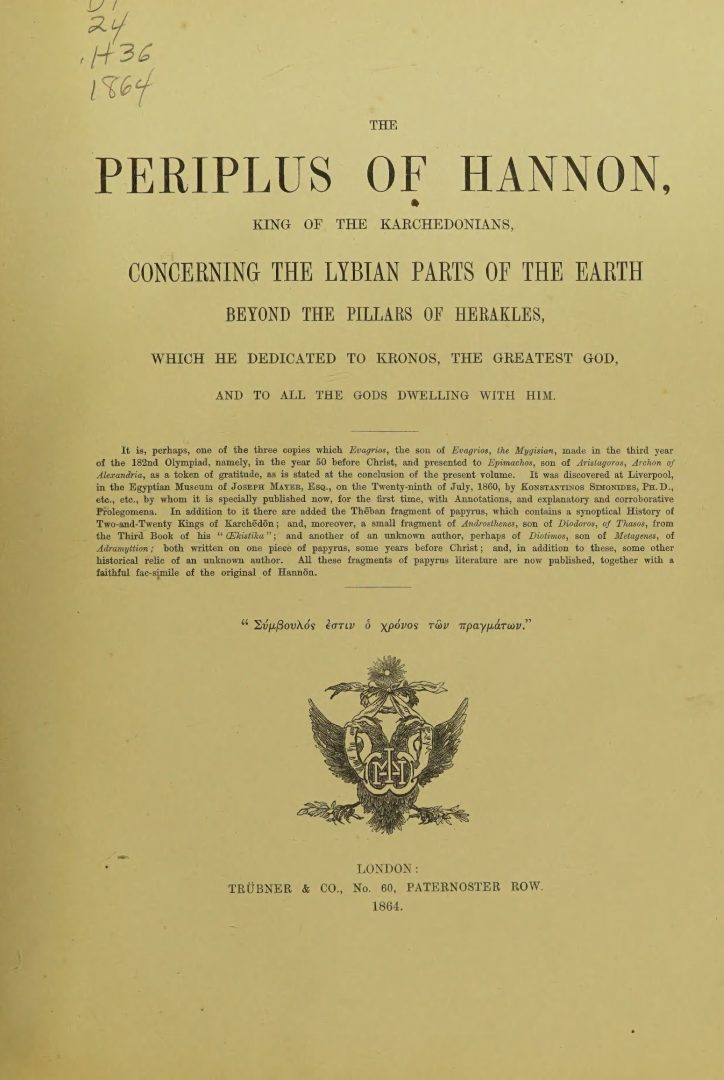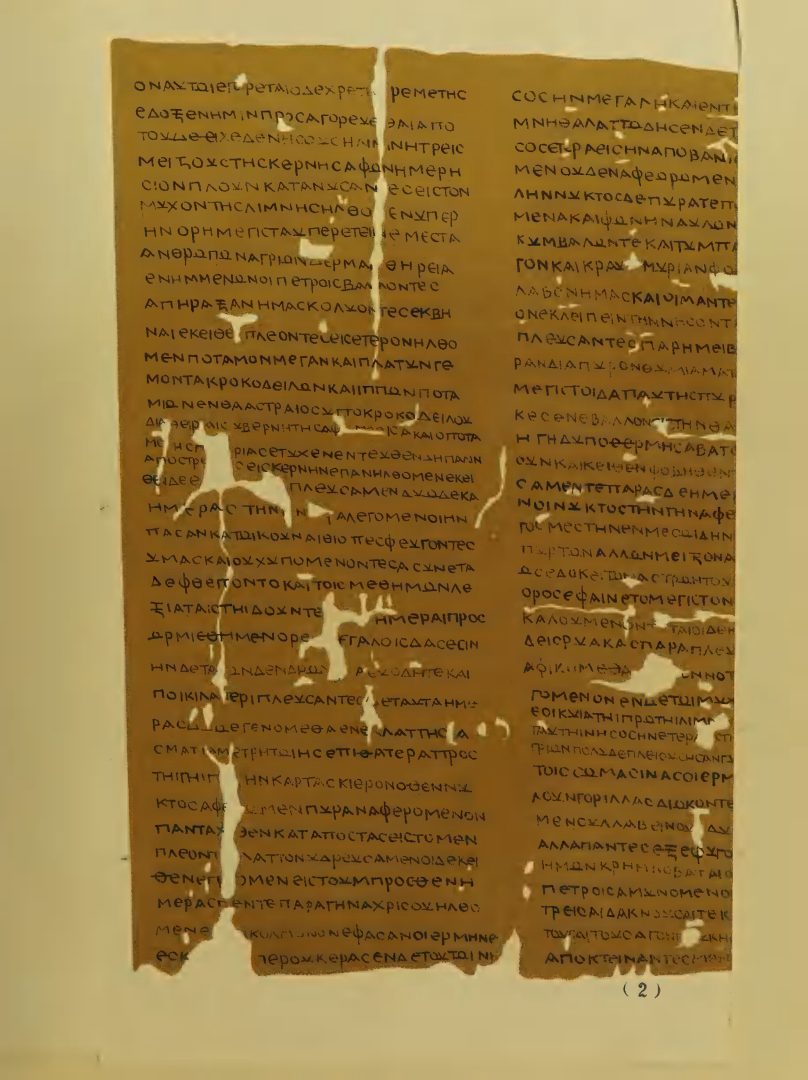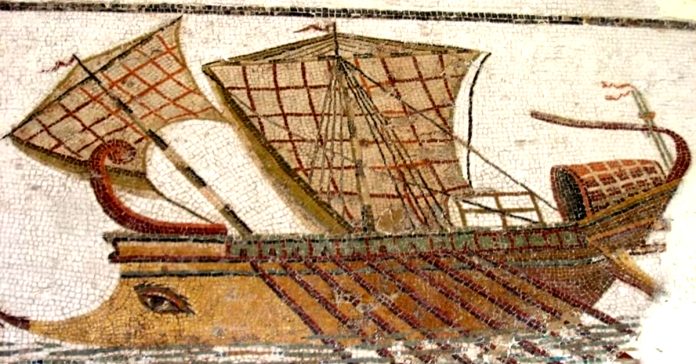A Carthaginian Odyssey Begins
The sea was the lifeblood of Carthage, a city born from the ambitions of Phoenician mariners and hardened by centuries of mercantile supremacy. By the 5th century BCE, it was the beating heart of a vast commercial empire. Its ships threading the arteries of the Mediterranean in pursuit of wealth, influence, and power. However, beyond the familiar currents flowed the Atlantic, a mysterious and perilous realm. Indeed, it remained known only through whispers of storm-wracked coasts and untamed peoples.
Hanno the Navigator ventured into this unknown frontier. So started the Periplus of Hanno.

Charged with leading an expedition that would cement Carthaginian dominance beyond the Pillars of Hercules, Hanno commanded a fleet of sixty ships. Each brimming with settlers, supplies, and the unrelenting ambition that had made his people masters of the sea. His mission was twofold. To establish colonies along the African coast and to push further than any Carthaginian had before. Mapping the lands, forging new trade routes, and gathering intelligence on what lay beyond the bounds of known geography.
Hanno‘s journey is to this day, chronicled in the Periplus of Hanno. A document of extraordinary significance, preserved not in its original Carthaginian script but through a Greek translation. A terse and enigmatic text, it describes an odyssey into the unknown. An account filled with glimpses of strange lands. Encounters with unfamiliar peoples, and visions of natural wonders few had ever witnessed. Some scholars regard it as a straightforward travelogue. Others see in its lines the hazy outlines of legend, a tale that dances between fact and myth.
The Departure
As the fleet slipped past the mighty Pillars of Hercules, today known as the Strait of Gibraltar, the world as they knew it faded into the horizon. This is where the Periplus of Hanno really began.. Ahead stretched the endless waters of the Atlantic. A sea whose true vastness neither Hanno nor his men could yet comprehend. The expedition had begun, and with it, Carthage sought to etch its name upon the unknown. But what awaited them beyond the horizon would test the limits of their courage and the boundaries of their understanding.

This was no ordinary voyage. It was a descent into the uncharted. A confrontation with nature in its rawest form, and a journey that would leave behind more questions than answers. The tale of Hanno’s expedition would endure through the ages, whispered by historians, debated by scholars. Its was and still is pondered by explorers who sought to follow in his wake. The journey of discovery had begun. The veil over the great African frontier was about to be lifted.
Periplus: Encounters and Discoveries
As Hanno’s fleet sailed deeper into the heart of Africa, the explorers found themselves in an ever-changing landscape. One vastly different from the lands they had known. The climate grew hotter, the terrain more rugged, and the peoples they encountered increasingly unfamiliar. Some were eager to trade, while others remained elusive, their customs and languages shrouded in mystery.The fleet discovered one of the most striking sights as they reached a land where dense forests, teeming with wildlife, lined the coast.
The Carthaginians observed great rivers snaking through the landscape. Some teeming with crocodiles and hippopotamuses, creatures they might have known from Egypt, but never had encountered before. The sight of such beasts, coupled with the sheer vastness of the land, instilled a sense of awe and trepidation among the crew.

Going South
Further south, the expedition encountered a people who painted their bodies with ochre. They spoke in what seemed to be an intricate series of clicks and whistles. Initial contact was cautious, yet trade was established. The Carthaginians offering trinkets and weapons in exchange for rare local goods. However, not all encounters were peaceful. At one point, theThe explorers approached initial contact cautiously, yet they established trade. fleet was forced to flee from hostile warriors. Their arrows raining down upon the Carthaginians as they hurried back to their ships.
As the fleet moved on, they encountered a landscape that seemed almost otherworldly. Towering volcanic mountains loomed in the distance, their peaks shrouded in clouds of smoke and fire. Hanno’s account describes the sight of a massive burning peak, which scholars today believe may have been Mount Cameroon. To the Carthaginians, it was a terrifying and mesmerizing spectacle, a place where, perhaps, the gods themselves resided.
Despite the growing hardships and unknown dangers ahead, Hanno resolved to pursue his voyage. The call of discovery was too strong, and the mysteries of the African coast too compelling to turn back now. The expedition pressed forward, sailing toward stranger encounters. These meetings soon left an indelible mark on Hanno’s legend.
Hano: The Land of Fire and the Beasts of the Night
During the Periplus of Hanno, his fleet ventured even further south, they entered a realm that seemed to defy the natural order. The sky darkened with plumes of smoke from great burning peaks, the sea shimmered under the eerie glow of molten rivers, and the very air vibrated with an oppressive heat. The Carthaginians, having witnessed many marvels, now found themselves in a land that seemed forged by the gods themselves.

In fact, Hanno’s account describes their arrival at a towering mountain, its summit lost in swirling flames and blackened smoke. The Carthaginians called it The Chariot of the Gods. Overwhelmed by the raw power of what modern scholars believe to be Mount Cameroon. At night, the fire atop the mountain blazed brightly. The surrounding land glowed with an unsettling, flickering light. Some among Hanno’s men believed they had reached the edge of the world. A place where the mortal realm touched the divine.
Strange Upright Creatures
But it was not just the landscape that defied expectation. The expedition soon encountered something even more astonishing, creatures unlike any they had ever seen. On the slopes of the mountains, in the dense forests beyond, they observed strange, bestial figures moving in the darkness. These creatures, covered in thick fur, walked upright like men but had the appearance of wild beasts. The Carthaginians attempted to capture some, but the creatures fought fiercely. They shrieked and bite with such savagery that the men were forced to kill several. The locals referred to them as Gorillai. A name that later echoed in accounts of great apes discovered in these regions. However, to Hanno’s men, they were something far more mysterious, perhaps even something beyond the natural world. Did this mark the earliest documented account of what we now know as Sasquatch?
After these harrowing encounters, fear and superstition gripped the crew. Some whispered that they had stumbled upon the lands of spirits or demons, places not meant for the living. The decision was made to turn back, their supplies dwindling and their mission having taken them further than any Carthaginian had ever gone before. And so, with their ships heavy with goods and their minds burdened with wonder and fear, Hanno and his men began their return voyage, forever changed by what they had witnessed.
The Return Journey and the Weight of Discovery
Therefore, as the fleet shifted northward, a blend of triumph and unease characterized the voyage home. Hanno and his men had ventured into lands unknown. Beheld landscapes of fire and beasts that defied reason, and encountered peoples whose customs and languages were as foreign as the stars above. Yet, despite their achievements, there lingered an unspoken dread among the crew. They had seen things that could not easily be explained, and such knowledge carried its own burden.
As the Carthaginians retraced their route along the African coastline, they stopped once more at their settlements and trading posts. Some colonies had thrived in their absence. Others had struggled, their settlers facing hardships that Hanno’s expedition could do little to remedy. Supplies were replenished, reports were gathered, and the fleet pressed onward, eager to return to Carthage with their wealth of knowledge.
However, the return voyage was not without peril. Storms ravaged the fleet, battering the ships with relentless winds and towering waves. The unfamiliar currents that had guided them southward now opposed them. Dragging vessels off course and forcing Hanno to make difficult decisions. In some cases, ships were lost, swallowed by the depths or forced to land in hostile territories. The journey, once an act of bold exploration, had now become a test of endurance.
The Pillars of Hercules at last
In the final leg of the expedition, the fleet once more passed through the Pillars of Hercules, marking their return to familiar waters. Though physically exhausted, Hanno’s mind was still alight with the mysteries they had uncovered. He knew that what they had witnessed would be met with both wonder and scepticism back in Carthage. The world they had mapped, the creatures they had encountered, the lands of smoke and fire, all would challenge the accepted boundaries of knowledge.

As they sailed into the great Carthaginian harbor, greeted by crowds eager to hear of their exploits, Hanno understood that their journey had been more than an exploration of new lands. It had been an expansion of human understanding, a confrontation with the unknown that would ripple through history. What had begun as a mission of expansion had transformed into something far greater. The opening of a door to realms unimagined.
The Periplus of Hanno and the Legacy of the Voyage
The voyage of Hanno did not end upon his return to Carthage. It merely shifted from the physical realm to the realm of history, myth, and scholarly debate. As the admiral presented his account to the Carthaginian Senate, his words were transcribed onto a stele and placed within the temple of Baal Hammon. Though the original record has long since been lost, later Greek and Roman authors preserved portions of Hanno’s account. Thus ensuring that his remarkable journey would not be forgotten.
Yet, as with all great tales of exploration, the Periplus of Hanno became more than a simple record of geography. It became a legend. The strange creatures, the fiery mountains, the shadowy lands beyond the reach of Mediterranean civilization. All of these fed into the imaginations of later generations. Some dismissed his accounts as exaggerations, while others saw them as glimpses into a world yet to be fully understood.

The descriptions of great rivers, dense jungles, and a burning mountain have led modern scholars to identify parts of Hanno’s route along the West African coast, perhaps reaching as far as present-day Gabon. His reference to the gorillae, the mysterious ape-like beings, has fueled endless speculation. Were they truly gorillas, unknown hominids, or something else entirely? The term he coined, gorillae, eventually named the large primates we know today, unexpectedly tying Hanno’s tale to nature.
A Legacy still unknown by must
Beyond the specifics of his discoveries, Hanno’s journey stands as a testament to human curiosity and the drive to push beyond the known. His voyage marked one of the earliest recorded sea explorations beyond the Mediterranean, demonstrating the Carthaginians’ mastery of navigation and their willingness to challenge the vast and mysterious ocean. His expedition was not merely about charting new lands—it was about confronting the unknown and returning to tell the tale.
Hanno’s legacy endures, not just in the fragments of text that survive, but in the very idea of exploration itself. His voyage, akin to those of later explorers, shows us the world stretches beyond our beliefs. Beyond our maps’ edges, wonders and truths await discovery..
Hanno Echoes of the Past
The tale of Hanno’s voyage, though ancient, still reverberates through time, shaping our understanding of early maritime exploration and the enigmatic corners of the past. His journey, inscribed on the stele of Carthage and passed down through classical sources, serves as both a historical document and a tantalizing mystery, one that continues to provoke debate among scholars, archaeologists, and historians alike.
The survival of The Periplus of Hanno through Greek and Roman texts has ensured that his odyssey remains a cornerstone of early exploration narratives. Yet, the gaps in the record and the layers of interpretation that have accumulated over centuries raise compelling questions. How much of his narrative captures actual truth, and how much springs from the mythic imagination of the ancient world? Did Hanno truly encounter the “gorillae,” or was this a distorted observation of something far more mundane? Were his descriptions of fire-spewing mountains and lands scorched red with heat exaggerations, or do they stand as the earliest documented observations of African volcanoes?
Modern scholars have attempted to retrace his path, aligning his descriptions with known geographical landmarks. The burning mountain, often identified as Mount Cameroon, aligns with his observations, while the great rivers and coastal landscapes suggest he may have ventured further than previously believed. The possibility that Carthaginians had knowledge of West Africa long before European exploration in the Age of Discovery challenges established narratives of maritime history. If Hanno and his fleet had indeed reached as far as Gabon or beyond, it would mean that contact between the Mediterranean world and sub-Saharan Africa was far more extensive than once assumed.
Academic Doubts
Yet, beyond academia, the deeper resonance of Hanno’s journey lies in its symbolic power. It embodies the eternal human impulse to seek out the unknown, to sail beyond the boundaries of certainty into the realms of possibility. His story stands as more than a historical note; it testifies to the enduring spirit of exploration, reminding us that history emerges not only in books, but also in the steps of those bold enough to tread unknown lands.
The Periplus of Hanno is more than an ancient document, it is a bridge between past and present, between legend and history, between the known and the unknowable. And so, his voyage endures, whispering across time, calling out to those who still dream of far horizons and untold discoveries.
Bibliography for The Periplus of Hanno:
Thomas Walter Wallbank, Civilization Past & Present Volume 1, sixth edition (Illinois: Scott, Foresmand and Company, 1987), 24.
Wallbank, Civilization Past & Present, 24.
Kingfisher, The Kingfisher History Encyclopedia (New York: Larousse Kingfisher Chamber, Inc., 1999), 29.
Carolina López-Ruiz, Phoenicians and the Making of the Mediterranean (Massachusetts: Harvard University Press, 2021), 120.
Wilfred H. Schoff, trans., The Periplus of Hanno, A Voyage of Discovery Down the West African Coast by a Carthaginian Admiral of the Fifth Century B.C. (Philadelphia: The Commercial Museum, 1913), 3.**
Schoff, The Periplus of Hanno, 5.
J.A. Brendon, Great Navigators & Discoverers (London: George G. Harrap & Co. Ltd., 1932), 20.
Schoff, The Periplus of Hanno, 10.
Schoff, The Periplus of Hanno, 20-21
Wallbank, Civilization Past & Present, 25.

